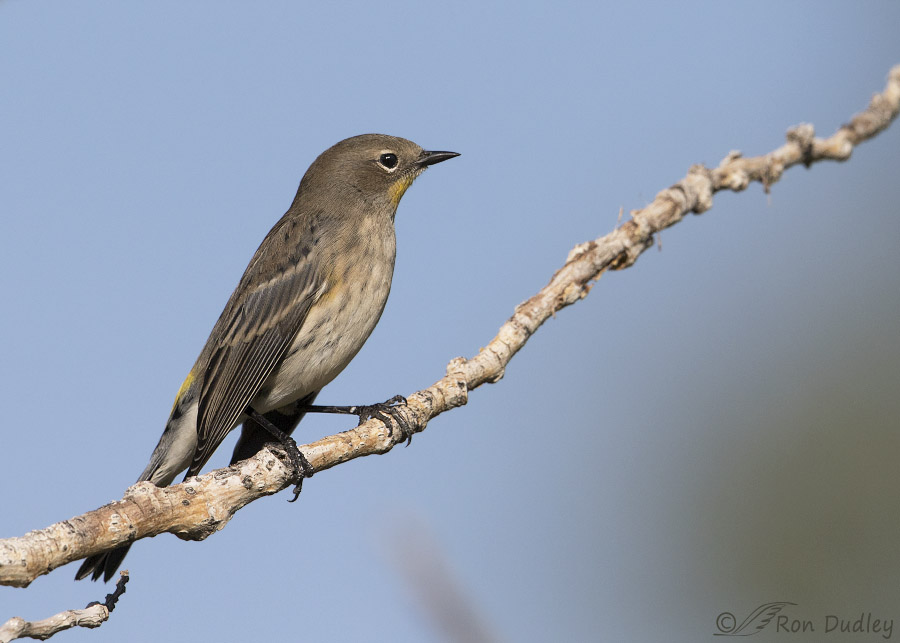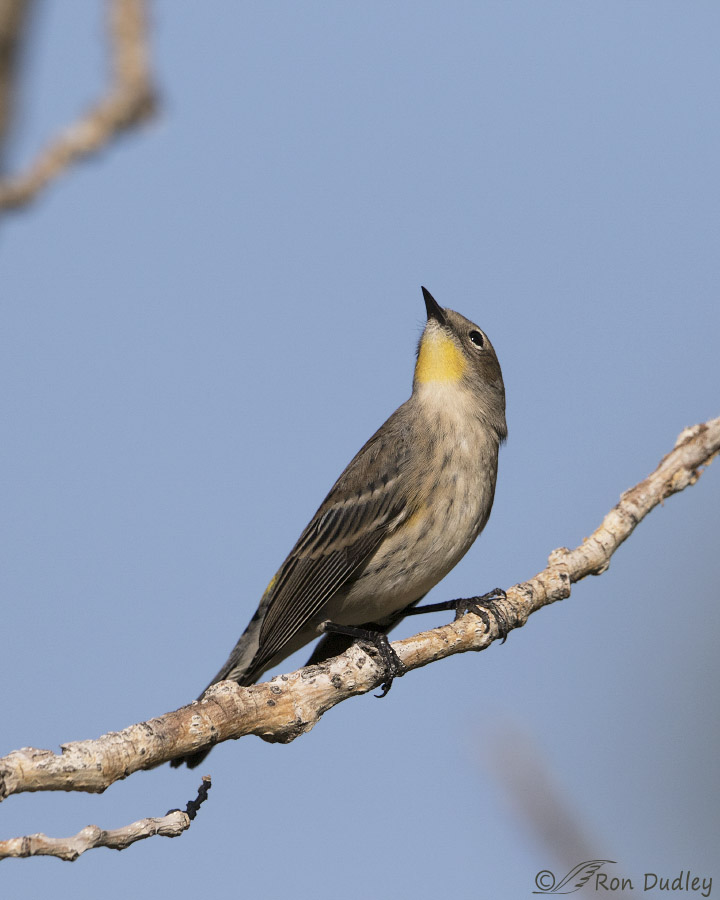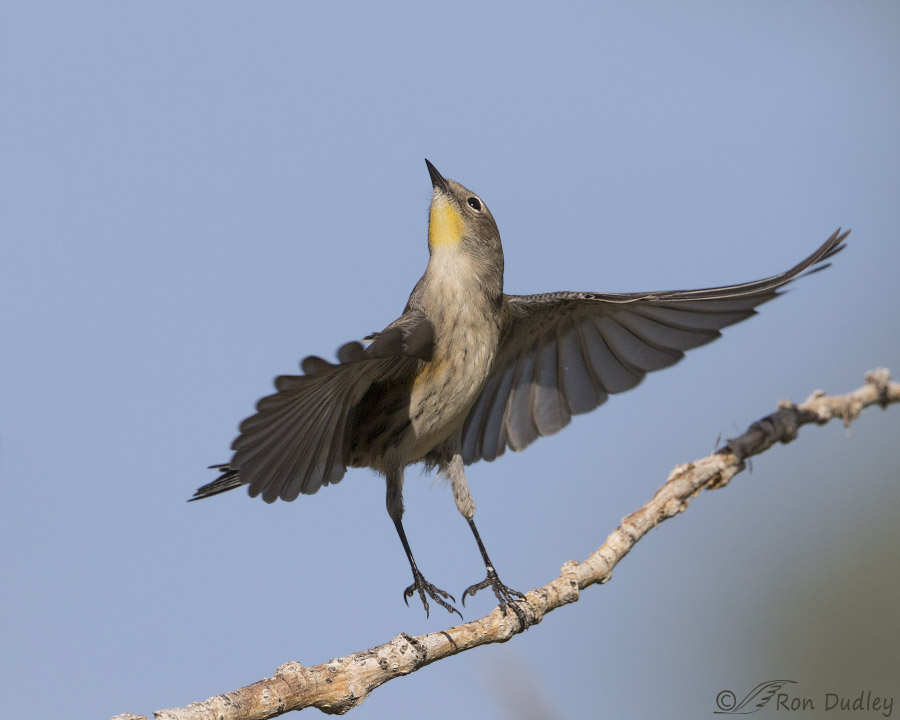It’s the third photo in this series that I like so much – mostly because anything like it has been so damned hard to get with these little speedsters.
Regular readers know I like action shots. I usually have my settings adjusted so I have more than enough shutter speed to freeze the wings of even the smallest, speediest birds. It doesn’t pay off very often and even when it does the results are usually on a continuum from mediocre to very good and the former usually predominates. So when I get an action shot that pleases me it’s quite rewarding.
There’s often a tradeoff for those high shutter speeds of course – slightly reduced image quality because of the high ISO’s usually required to get them. But I’m more than willing to pay that price – good, bad or indifferent it’s just my style.

1/6400, f/6.3, ISO 640, Canon 7D Mark II, Canon EF 500mm f/4L IS II USM + EF 1.4 III Extender, not baited, set up or called in
Yesterday afternoon I spent some time at the “warbler tree” again and found this one on one of those rare perches with a relatively clean background. Here the bird is looking out over the water for flying insects. When they spot one and take off after it I’m always trying to get takeoff shots but these very small birds are so incredibly quick that human reflexes just aren’t fast enough to get them in frame when they’re close enough for good detail.
But occasionally I get lucky.

1/8000, f/6.3, ISO 640, Canon 7D Mark II, Canon EF 500mm f/4L IS II USM + EF 1.4 III Extender, not baited, set up or called in
This time the bird spotted a bug that was directly overhead – which meant it had to angle its head upward to follow it. That was a behavioral cue for me that it might be about to take off after the bug so I fired off a quick burst…

1/8000, f/6.3, ISO 640, Canon 7D Mark II, Canon EF 500mm f/4L IS II USM + EF 1.4 III Extender, not baited, set up or called in
and caught the warbler launching vertically. There’s enough light under the wings for pretty good detail, I was close enough to the bird so this is not a large crop and I even got a catch light in the eye with the head at this unusual angle.
There were a couple of blurry twigs in the upper left corner that I found quite distracting so I reluctantly removed them but I’ve left them in the previous image so viewers can see most of what I removed.
It’s very possible that I like this image more than most others will but for me “degree of difficulty” often plays a role in my appreciation of my own photos. After hundreds of recent attempts at getting a shot like this it felt good to finally succeed.
Ron
Note to photographers: These warblers are so darned fast that I’ve found 1/3200 sec to be too slow of a shutter speed to freeze their wings. 1/5000 probably would have done it but with this bird I had a little extra wiggle room for insurance. Better too much than too little…


Simply spectacular! Sorry to be late, but that’s the story of my life right now. Just wanted you to know I fully appreciate the “degree of difficulty” aspect!
Oh, I love these photos, especially the last one. He/she looks like a little ballet dancer in mid twirl. You do take fantastic shots of these little guys. Of course I love all of your photos but knowing how fast they are makes them extra special. Thank you Ron.
The Yellow Rumps just arrived here. A bit early this year. Love the last pic Ron!
Thanks, Jean.
The little birds make greased lightening seem slow and predictable don’t they?
Love the balletic pose you captured in the third, and am so pleased that all your persistence finally paid such a generous dividend. For you and for us.
They sure do, EC. And lightning usually goes down but birds can and do go any direction!
Delightful! I too admire how you tune into the birds and anticipate possibilities! I realize it’s the result of years of focused loving attention, dedication to detail and wading through ‘outtakes’. I’m very grateful.
You’re right, Alison – “wading through the outtakes” can be a painful experience when I realize that if I’d just done something slightly differently I’d have a nice shot instead of just fodder for the trash bin. I learn from that stuff!
So, now that we all apparently have an indoor, rainy day and have time to wade into this stuff….
Since our cameras can easily take 1000 pictures in a session due to the 10 frames per second and these slippery warblers I am amazed how much time it takes to cull these “outtakes”.
I have about a 10% keep rate at best of times. My method is to use a combination of first grid view and then single picture view and a filmstrip to go through them all “x” keying the ones to reject them and mark them for subsequent deletion in Lightroom. I would like to select a group at a time with shift-click or whatever but am paranoid about thus deleting a keeper so I have to x-key them more like one at at time.Then I pick the keepers only to put a quality rating (star) on them for post processing and ones I post and publish I put a green color on them in order to remember which I did that too. I usually run a backup before this culling step but after import.
Even with that it takes probably an hour per session to do the culling – not counting the post and publishing. Even with serious culling my library of kept images is almost 100K in size. What is your method and experience?
Thanks…
I estimate that I also keep about 10% or maybe slightly less. Because of blogging I keep far more of them than I otherwise would because I use some of those “marginal” shots to help tell my stories and document behaviors. So when I’m culling I always have to keep potential interesting stories in mind.
I use PS Elements for my organizer and to cull from. I briefly look at each photo individually and then if I think one has potential I look at that image at “100%” to check for sharpness. Once I’ve pulled out my keepers and dragged them to their proper species categories I can delete as a block. It isn’t unusual for me to delete hundreds of images with a single click of the mouse.
Yes, culling is a royal pain in the patoot!
That third shot is spectacular. It probably could have survived with those blurry twigs (I don’t think I really noticed them in the prior shot until I went back to look at it again), but I can see why you took them out. I really like the second shot, too. In all of them I love the detail of the feet.
Susan, Those blurry twigs in the third shot bothered me more than I thought they would – the horizontal composition (as compared to vertical in the second shot) probably contributed to that.
An interesting behavior. I didn’t know they could even do thet…its “different” shots like these that keep your postings so interesting…thete is ALWAYS something new to learn from them…
“Different” is my middle name, Patty – in more ways than one…
I like it!!!
That’s why we keep comin’ back!
Excellent shot Ron, great job!!
I’m glad you like it, Dick. Thanks.
Congrulations Ron! You nailed it!
Charlotte
Thanks, Charlotte.
You definitely nailed it! Hopefully, the warbler was as successful with his high degree of difficulty shot as you were.
Thank you, Marty. I’m not sure if the bird nailed the bug but there’s no question it was after one and more often than not they’re successful.
Magnificent captures of a gorgeous bird. I admire your timing reflexes in catching these little buggers. For me, it is more miss than hit by a wide margin.
I’m always amazed at your shutter speeds (1/8000) and, to me, low ISO’s (640) shooting in an aperture mode of 6.3. I have tried this many times after enjoying your posts and can’t match those settings with my Nikon D7200 unless I’m in Manual mode…and even then it is darn hard! What is your secret?
TIA
“What is your secret?”
James, I can only guess that it’s the light-gathering ability (speed) of our respective lenses. My lens is an f/4 – what lens are you using?
Generally the Nikon 200-500 f5.6 and I realize this is a handicap, especially in low light, and frustrating! However, in good light, I have to up my ISO to 1200 or higher to get similar shutter speeds as you and then have to use Manual mode. Anyhow, I will keep practicing as I otherwise like this lens and camera.
Thanks for answering my question, James.
Yup, the difference seems to be the light gathering ability of our respective lenses. Faster lenses are very nice to have for bird photographers because birds are so darned fast but we do pay a huge $ premium for those lenses when we buy them…
Ron, your action shots are my favorite part of your work. And your tech. skills. Oh and your behaviour knowledge. And your anatomical skills.
But anyway, you normally shoot in aperture priority and then adjust mostly ISO to force the high shutter speeds, correct? I have been trying your method with my 7D Mark II but still keep wanting to shift to shutter priority for better control. You shot this with your f/4 long lens but then had the extender on it causing the f/6.3 in the last image? I too struggle with getting my speeds over 1/2000 but admittedly haven’t been able to position myself in the right situation with golden light with catch light possibilities with good birds and close enough for my new EF 100-400 L f/4 lens. But you do it more or less routinely mister.
“your action shots are my favorite part of your work”
We think alike, Art!
Actually I probably use aperture changes almost as often as I do adjusting ISO to get the SS I’m after. Or a combination of both.
And I could have gone to f/5.6 with these shots but with the tc attached I can’t go to f/5 or f/4.
I appreciate your kind words very much.
Thanks. So, all this on the fly adjustment is really hard with these slippery warblers.
Is this how you do it? Lens and camera resting on your pool noodle, looking through your viewfinder trying to anticipate the leap off the twig you are actively changing aperture with your right index finger and moving that finger to the ISO control button and then back to the index finger to adjust and then, hopefully, back to the shutter in order to hopefully trigger a capture in time? Whew…
I know, I know, probably TMI for most readers but as I practice I keep thinking about how to get my skills up to approach Dudley-esque precision…
Ha, I’m not as fast (or as good) as all that, Art!
For fast little birds like these warblers I usually just put my settings at the best compromise I can find and then fire away. They usually go into and out of light very fast and the darkness of the backgrounds also changes so my SS’s are usually bouncing around. That’s why I usually try to err on the side of too much SS rather than too little. Too much doesn’t hurt much but too little does. In these situations the settings I change most often are those for exposure rather than SS.
And like all bird photographers I butcher a lot of shots…
Very interesting. Forgive me if my questions are becoming tedious. I appreciate the learning.
So, you examine individually and drag keepers elsewhere and then you can delete the remaining ones in bulk. Your organization is by species. I will have to consider aspects of this to somehow improve my workflow.
I organize by event or “roll of film”. I.e. 2017-09-27-EastCanyonBirdTrip. That way I can tie my photos by the folder date name to my fundone folder where I keep track of all my trips and events (and the source of my email domain (***@fundone.org). Instead of dragging keepers elsewhere I cull in-place in their permanent home. Probably a little faster than your process. I think I may start tagging by species -that is a great organization idea.
I also keep many pictures that are just snapshots – to share with people that were with me or to tell a story. I post stories at backcountrypost.com. Much of my photography is not bird-related but the percentage that is is steadily increasing with my new, fast camera and lenses and your inspiration. Eventual retirement will increase it even more.
When I say I “drag my keepers” I’m not dragging them “elsewhere – they’re still where they originally were in PS Elements. They’re just categorized by species (and date of course).
Congratulations! All that time and effort paid off handsomely. Absolutely gorgeous wing positions – makes me want to take right off and soar, too.
Thanks very much, Robyn.
Wow, that’s fast: the bird and the shutter speed. Must have been really bright out because, from my perspective, ISO 640 is not really that high. I found high ISO’s with the 7DII to be a problem and one of the reasons I went to full frame cameras. However, as you continuously demonstrate, excellent images can be made with that body in the right hands. Another great post Ron. Thank you.
Frank, these photos were taken at 4:55 PM on a clear sunny day (one of the rare times I was photographing in the late afternoon instead of early morning) so I had plenty of light for fast SS’s with my lens. Thankfully the sun was low enough in the sky that the light angle worked out too.
I’ve never had much problem with noise with the Mark II but of course selective sharpening helps too.
Beautiful! Catching the take off has me grinning ear to ear.:) I KNOW how difficult anticipating the little birds movements can be and you nailed it – congratulations:)
Thanks, Judy. I hoped that some viewers would appreciate the degree of difficulty.